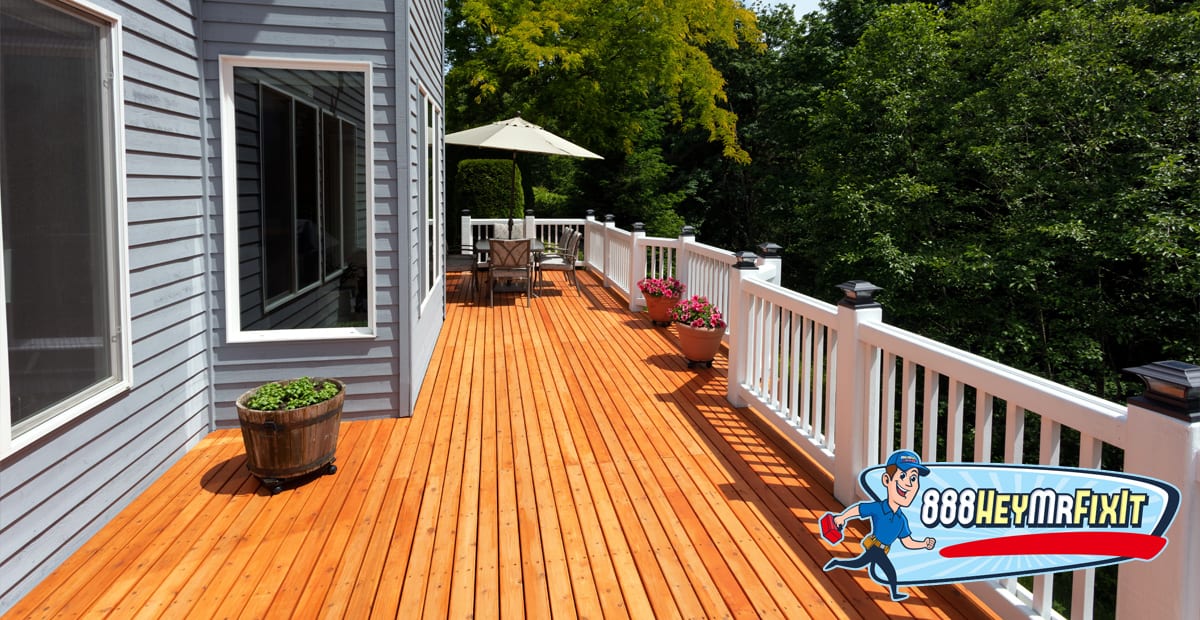
With spring right around the corner, many Marylanders are thinking about what projects they’ll get done outside once it finally dries out. One of those questions might be should you replace or repair your deck?
No matter how old your deck is, it should be inspected annually to determine if repairs are needed. Regular inspections can help avoid costly repairs and it will keep your family and friends safe when occupying the deck.
When the weather clears and there’s been a few days of dry weather, give the deck a thorough once-over to determine if it needs repairs or if it’s time to replace it.
Check the Ledger
The ledger is the framing material used to attach the deck to the house or other structure to keep it secure. The #1 leading cause of collapse on a deck is rotted or decaying ledger, according to the North American Deck and Railing Association.
Take a look at the flashing to make sure there are no holes or rust present. Lag screws should be used to attach the ledger to the home, not nails. If the flashing looks like it needs to be replaced or is attached with nails, it’s best to have a professional like 888 Mr. Fitxit inspect and determine if a repair is an option or if the entire deck needs to be replaced.
Check for Rot, Cracks, and Splinters
If the deck is made of wood, inspect the posts, stringers, and floor boards for rot. You can use a screwdriver to probe the wood for soft spots.
Take notice if the deck is swaying, sinking, or heaving in any direction. Anything other than a solid structure could mean rot is present, even if you can’t see it.
If you find small spots, you might be able to remove the rot and treat the hole with wood preservative to stop the spread. A bigger spot likely requires replacement of the affected boards and may indicate more rot in other places, signaling a full deck replacement is needed.
Regular sealing of deck boards can improve their lifespan, but eventually, the wood deck boards will have to be replaced. If a few boards are damaged, replacement might work but if it’s more than that, it could be time for a full deck replacement.
Check Beams and Joists
The wood should be free of rot and the connecting hardware free of rust. If you find either, removal and replacement is the preferred option to repair the deck.
However, depending on the level of decay and location, reinforcing the older beams or joists is another option. This would require building a new frame around or next to the existing structure and connecting them together.
Inspect the Railings and Stairs Closely
Stairs collapsing and railings giving way are common causes of deck failures and injuries. Test each stair to make sure it still feels solid underfoot and there is no sagging or squeaking, which could mean loose or broken screws.
Make sure there are no loose posts or handrails. If you find any, you might be able to reinforce them with outdoor screws, depending on the wood’s condition. But if there are multiple loose stairs or railing sections, this could indicate a larger problem, which could signal that it’s time to replace the deck.
Inspect the Footings
If the deck footings are in the ground, inspect near the ground for wood rot or erosion around the posts. If concrete footings were used, make sure they aren’t dropping or cracking. Soil underneath can shift over time causing cracking, but so can the freeze/thaw cycles we see often during winter in Maryland.
Make sure water isn’t draining from downspouts or pooling near the deck footers. This can greatly reduce the lifespan of your wooden deck and cause premature rot.
When to Call the Professionals
If you’re not sure about the DIY approach for inspection, 888 Mr. Fixit can do it for you. We’ll come out to inspect and help you decide if it’s worth repairing the deck or if the time has come for a replacement.
At 888 Mr. Fixit, we can handle the entire process so you don’t have to. Call us today for a free estimate to find out if you should repair or replace your deck.

